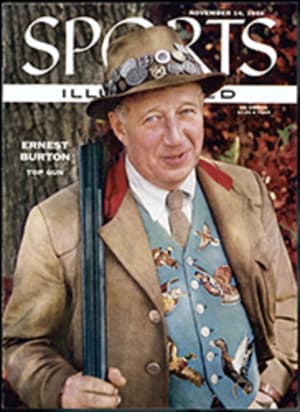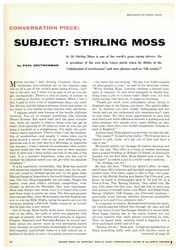
YANKS CAPTURE JAPAN
It was 10 minutes of 4 one day last week in the Japanese city of Nagoya, and out at Chunichi Stadium the baseball game was in the last of the eighth. Tommy Sturdivant was pitching for the New York Yankees; Nagoya's Chunichi Dragons had the bases loaded, two out, and the count three-and-two on the batter. Casey Stengel was already clomping up out of the dugout, and all Nagoya that wasn't at the ball park leaned closer to the radio.
At precisely this moment a young bank robber ran into a downtown Nagoya bank, scooped up 2 million yen and jumped into a waiting taxi. The engine stalled and that was that—but until then the bank robber had been working on eminently sound principle. That is, there's no better time to heist a Japanese bank than when everybody in town has his mind on Casey Stengel and the Yankees.
Japan has seen a lot of American major leaguers, starting with John McGraw and Charlie Comiskey back in 1913, going up through Stengel himself in 1922, Babe Ruth and Lou Gehrig in 1934, and Mrs. DiMaggio just last year.
But the current six-week Hawaii, Japan, Okinawa, Philippine and Guam tour is the first time the Yankees have ever come out to the Orient as a team; for the Japanese, who take baseball with a combination of holy dedication and bizarre innovation completely their own, this has presented numerous opportunities.
The promoters have been able to figure a way of throwing in the first ball appropriate to the age; dropping it from an airplane swooping low over second base. The Japanese public has been able to paw their heroes happily in delirious mob scenes; a few have even been able to invade the Yankee dugout and get autographs from a team that seems to do nothing between times at bat except wear out fountain pens (literally) signing boxfuls of souvenir baseballs.
Japanese sportswriters have been able to question Casey Stengel on everything from the Yankees' signing of an Hawaii-born Japanese as a Yankee scout (Stengel insists the club was dead serious in this) to why Japanese batters couldn't seem to get a clean swipe at Jim Konstanty's deceptively slow pitches. (Konstanty is a big right-handed relief pitcher whose effectiveness depends on precise control.)
Casey was holding court in the anteroom of the gigantic Koshien Stadium, just outside Osaka, when the last question came up. Around the big cloth-covered conference table were gathered a score of reporters. In the middle of the table were three wilting chrysanthemums in a flowerpot. Casey sat slumped with his head on his hands. After the question he waited a moment, then leaned forward and in a hoarse, confidential whisper divulged Konstanty's secret:
"He's got radar in his arm."
Casey ran one hand up the other arm, making butterfly motions with his fingers, to indicate just how it all worked. Turning to the interpreter, he added:
"Tell them it's the disappearing ball that he throws." With this Casey lifted the tablecloth and started hiding under it. In a moment Casey's white head popped out again and then Casey himself emerged to explain further: "Course this don't go when they hit him, you tell 'em."
Relaxed off the field, enjoying what is essentially a vacation trip (Robinson, Carey and Kucks are all on their honeymoons for that matter), the Yankees were still paying their Japanese hosts the ultimate compliment of serious baseball on the diamond.
Nobody was pretending that Japanese play yet was completely in a league with the American, but to Casey's eye it was improving fast. "Now some day if you said you had four or five players who could hit and five players who could play like the Japanese do now, you'd have the same as an American team because the American teams got too much punch for triples and doubles—the Japanese are going to come out sometime with a Rizzuto who can execute every type of play or a Nellie Fox of the White Sox or a Maranville, who can execute plays even though they are small of stature, and they're bright from the shoulders up."
Casey settled back in his chair. The train was rattling south from Nagoya on toward Osaka, where the Yankees were spending the night.
It was cold outside, but the coaches were overheated and stuffy. Up front in the car a desultory card game was in progress. For anyone who cared to listen, Stengel started declaiming. Autograph hunters were interfering with pregame practice, he was saying. "You don't want to see a lousy infield for 50,000 people just for some autographs, d'ya? Those people who come out for six or 10 hours, they want to see a good workout. Sure. Now you saw that one a couple days ago. A disgrace, that's what. We're paid to look good out there." Around him a couple of his audience nodded.
Farther back in the car, Umpire John Stevens was talking about the rules-interpretation meetings and umpiring clinics he had been conducting with Japanese umpires. Quiet, likable Bill Dickey dozed, while Jim Turner, Stengel's pitching coach, gazed out at the stations flashing by. They clicked past like the stations south of Chicago—only this was another country and the stations had strange names: Samegai, Maibara, Hikone.
NOT SO FAR FROM HOME
"You never know how the other half lives until you get here," said Turner, "and then of course it's not the other half any more." Turner is from Nashville, and he has a soft Tennessee voice. He went on, comparing the places in Japan he had been so far. "I've watched the people everywhere we've gone. I like to look at their faces. You know, if I were picking a place to live here, have a home and have a business, I think I'd take Osaka. I like it better than Tokyo."
Osaka or Tokyo, it was still a long way from Nashville. But the Yankees—and all the American baseball players before them—had helped make it a lot less far. In this context, it made little difference that the Yankees were winning everywhere (only one tie marred their record); visiting American teams usually won anyway. Or that on that three-and-two pitch in Nagoya, while the bank buster was scooping up the 2 million yen, the Japanese batter had grounded out, and the locals had lost seven to nothing.
The sport itself was the thing. The fan in the grandstand knew it. The Prime Minister of Japan, a sound politician who stuck a Yankee cap on his head as he greeted members of the Yankee party; knew it, too. Even history knew it. As the 1955 Yankees entered Koshien Stadium they passed a bronze plaque bearing a bas-relief of a baseball player. On it was an inscription that read: "In memory of Babe Ruth (1895-1948) who played at Koshien Stadium in 1934."
They were there to play baseball, and play baseball they did. But in between—when they were not at official receptions or making theater appearances—the Yankees and their wives had fun being tourists. They visited tearooms, tried out chopsticks, went shopping for kimonos and were entertained by geisha
Yankees on stage of Nippon Theater in Tokyo grin in amusement as left-hander Whitey Ford accepts bouquet of flowers from tiny Japanese girl wearing elaborate kimono.
Yanks at party in their honor at Tokyo's Nikkatsu Hotel were welcomed by Hiraku Watanabe of newspaper sponsoring tour. Here he greets Yogi Berra and Yogi's wife Carmen.
Yanks in teahouse ate sukiyaki, drank sake, watched geisha sing and dance. Pitcher Tom Morgan, with wife, Wanda, laughs as he is fooled by geisha's cat's-cradle trick.
Yanks in Kimono shop include Gil McDougald (lower left) who watches wife Lucille (center) and Wanda Morgan try on kimonos. Price is 40,000 yen, or about $110.
PHOTO
JEAN LAUNOIS
MANAGER CASEY STENGEL SHARES SPOTLIGHT AT TOKYO PRESS-CLUB LUNCH WITH PRETTY ENTERTAINER KEIKO KONDO, WHO WAS UNWRAPPED FROM BIG BOX ADDRESSED "FOR OL' CASE"
PHOTO
JEAN LAUNOIS
WOMEN WEAR COLORFUL KIMONOS TO GAME
PHOTO
JEAN LAUNOIS
MICKEY MANTLE WAS HERO TO JAPANESE DESPITE STRIKING OUT THREE TIMES IN ONE GAME
PHOTO
JEAN LAUNOIS
DAPPER MAN, BIG-EYED BOY WATCH POP FLY
THREE PHOTOS
PRETTY LUCY CAREY, WHO WAS ON HONEYMOON, TRIES CHOPSTICKS, LOOKS UP AS HUSBAND ANDY, YANK INFIELDER, TAKES SNAPSHOT OF HER STRUGGLES, STICKS TONGUE OUT AT HIM IN BRIDELY GRIMACE
FOUR PHOTOS
PHOTO
Casey Stengel, famous for his wildly rambling interviews, fixes gimlet eye on Japanese reporter between answers at Tokyo airport welcoming session.

